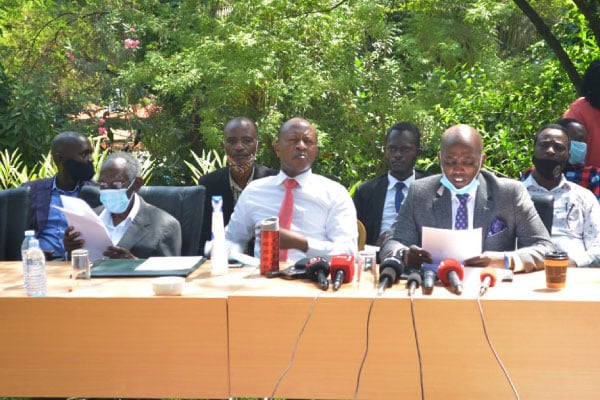Uganda’s satellite launch postponed – govt

Left to right: Mr Edgar Mujuni, Mr Bonny Omara, and Mr Derrick Tebusweke, the developers of the PearlAfricaSat-1 satellite, pose for a photo in May. Inset is the PearlAfricaSat-1 satellite. Photo / Courtesy of Omara
What you need to know:
- The launch, which is supposed to be accomplished by America’s National Aeronautics and Space Administration (NASA), was initially scheduled for September 28.
The launch of Uganda’s first-ever satellite, PearlAfricaSat-1, has been postponed to October 28 because of bad weather.
The launch, which is supposed to be accomplished by America’s National Aeronautics and Space Administration (NASA), was initially scheduled for September 28.
But in an interview with the Monitor yesterday, Dr Monica Musenero, the Minister for Science, Technology, and Innovation, said: “NASA shifted the date. We are launching it on October 28.”
One of the satellite developers, Mr Bonny Omara, also confirmed the development, adding that deployment into the orbit will be done in early November.
The government said it has established a station at Mpoma in Mukono which will serve as the operations and communications centre for the satellite. The government has already invested more than Shs7 billion towards the innovation, a development that has attracted mixed reactions from the public.
Some members of the public and legislators challenged the government’s focus on satellites, saying the country should rather focus on improving the well-being of the citizens and other areas that the country can favourably compete in.
“We have not achieved middle-income status. Let’s first get there and then we can think of such ambitious projects,” Dr Andrew Turiheihi, a dental surgeon, said on Twitter.
Ndinawe Johnmark, a resident of Kampala, said: “First of all, we need to get stable electricity in the capital, Kampala. Prioritisation in this matter is very important but do we even have the money to spend on that nonsense?”
However, Dr Musenero, while defending the investment in the innovation earlier, said the satellite will improve the accuracy of weather and disaster predictions thereby optimising agricultural production, improving food security, and reducing preventable deaths.
Farmers said last season that they counted losses after following weather predictions from the Uganda National Meteorological Authority (UNMA) which were inaccurate. The country has been experiencing disasters such as landslides and flooding which have killed many people.
But Dr Musenero said the satellite is the answer. She said owning a satellite will reduce UNMA’s reliance on data from foreign sources which may not be accurate.
Dr Abubaker Waswa Matovu, a lecturer in the Department of Electrical and Computer Engineering at Makerere University, said earlier that the technology will help people get essential information about rainfall and landslides faster.
“We want to see how we can relay information to ordinary people much faster. So with the satellite, we can send information without the ordinary person having to wait for a bulletin to know that there is a risk of landslide or there will be rainfall,” he said.
The satellite developers Edgar Mujuni, Bonny Omara, and Derrick Tebusweke, in May handed over the technology to Japan Aerospace Exploration Agency (JAXA) for final testing and approval ahead of the launch.
about the satellite
The development of the PearlAfricaSat-1 is part of the Joint Global Multi-Nation Birds Satellite Project. The initiative began in October 2019 after the President directed the development of a National Space Agency and Institute.
The development followed Uganda’s deal with Kyushu Institute of Technology (Kyutech) in Japan, and involved upskilling the three graduate engineers to design, build, test, and launch Uganda’s first satellite.




